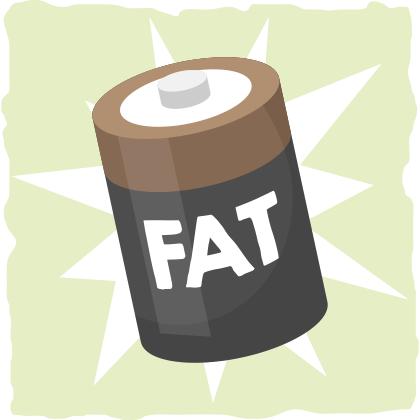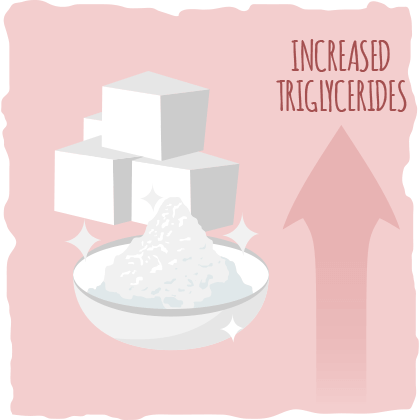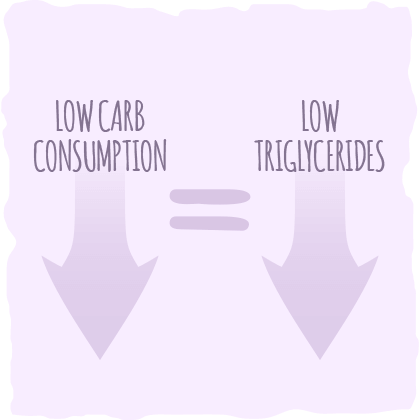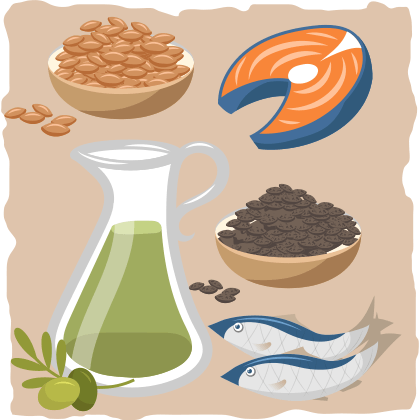You (or a loved one) probably have high triglycerides. This sounds like the beginning of a drug commercial, but it’s true.
Over 30% of the adult United States population has triglyceride levels that are equal to or above 150 mg/dL. In other words, about 1 in every 3 people has above normal triglyceride levels. So, what does this mean exactly?
What should you do if your doctor says that you have “high triglycerides”?
Let’s take a closer look at these crucial questions and help you find the solution:
- Why lowering your triglyceride matter
- What are triglycerides exactly?
- What causes high triglyceride levels?
- Uncovering the optimal diet for high triglycerides
- How keto and Mediterranean diets help decrease triglyceride levels
- Meditteranean-style keto: The best diet to lower triglycerides?
- Ten more triglyceride lowering tips
- Three things to avoid that cause high triglyceride levels
- Key takeaways
Why Lowering Your Triglycerides Matter

Lower triglyceride levels are one of the many indicators for better health, while high triglycerides are associated with several health conditions, including the following:
- An increased risk of heart disease. Studies suggest that high triglyceride levels impair cholesterol levels, increasing the amount of atherogenic (plaque-forming) cholesterol particles in the blood. Over time, this can cause plaque to accumulate in our blood vessels (a process known as atherosclerosis) and increase the likelihood of having a heart attack.
- Obesity. One study found that approximately 80% of people who are obese or overweight had triglyceride levels ≥150 mg/dL. This suggests that obesity and high triglyceride levels are closely linked. The opposite is true as well — When we lose weight, our triglycerides tend to decrease significantly.
- Metabolic syndrome. The prevalence of triglyceride levels ≥150 mg/dL is nearly twice as high in people who have metabolic syndrome. Metabolic syndrome is a condition that is commonly diagnosed when the person has high blood pressure, high blood sugar, excess body fat around the waist, and abnormal cholesterol levels.
- Excess visceral fat (fat around the organs). Excess body fat is associated with elevated triglyceride levels, but visceral fat is a greater contributor than subcutaneous fat (fat that is found under the skin rather than near vital organs).
- Poorly controlled type 2 diabetes. Around 35% of people with type 2 diabetes have high fasting triglyceride levels. This suggests that blood sugar and triglyceride levels are intimately linked.
- When the levels of thyroid hormone are low, cholesterol and triglycerides stay in the blood for a longer period of time, which increases the likelihood of heart disease and fatty plaque build-up in the arteries.
- Kidney disease. Triglyceride levels of >200 mg/dL are present in about half of those with chronic kidney disease, which is commonly caused by diabetes and high blood pressure.
- Rare genetic conditions. Ridiculously high triglyceride levels ( >1000 mg/dL) or chronically high triglycerides that aren’t easily explained by dietary and lifestyle factors are associated with rare genetic variants. However, in most cases, these high triglyceride levels can be addressed with diet and lifestyle changes.
It may be worrisome at first because of all issues that are associated with high triglyceride levels, but it is nothing to go to the hospital over. As with other biomarkers, your blood triglyceride results should only be interpreted along with a multitude of other validated measures for an accurate assessment of your overall health.
Our triglyceride levels do, however, provide us with important clues. The relatively strong association between triglycerides, blood sugar, cholesterol, and many of the conditions listed above give us a clearer picture of what causes high triglyceride levels and how to optimize them.
What Are Triglycerides?
Triglycerides are the most potent source of fuel that you store in your body. They are so energy-dense that stored triglycerides can keep the body going for about a month.
Where exactly are stored triglycerides found in your body? Well, you already know. You just call it “fat” instead of “stored triglycerides.”
Yes, triglycerides are the things that are being stored in your fat cells. While we are fasting, restricting carbohydrates, or limiting calories, these triglycerides are liberated from our fat cells to provide us with energy. This process is what helps us lose fat and reduce our triglyceride levels.

Why Do You Have High Triglycerides?

However, one big problem arises if we live in westernized societies — there is an over abundance of food at all time. If you are reading this right now, you probably live in an area where many different varieties of food are always available. In this kind of food environment, our emotional and instinctual desires override all logical sense, so most of us eat more calories and carbohydrates than we need.
In response to this influx in calories, the cells become stuffed with so much energy that they reject the signal to take more energy in that they receive from insulin (an energy storage hormone that is stimulated the most by carbohydrate consumption). This is otherwise known as insulin resistance, and this causes a cascade of hormonal changes that increase blood sugar and triglyceride levels.
On top of that, carbohydrate consumption (especially the consumption of processed sugars like fructose) stimulates hepatic lipogenesis (the creation of fat in the liver) independent of insulin signaling.
What all of this means is that eating excess calories increases your chances of having high triglycerides levels and eating excess carbohydrates increases triglyceride levels, especially if those carbohydrates are coming from fructose and other processed sugars.
Hold on. What about the fat?
We are talking about triglycerides — a type of fat. How could I talk about calories and carbohydrates and neglect to mention fat as a contributor to high triglyceride levels as well? Well, there is a good reason for that.
Sugar Can Become Your New Fat
It would only make sense for fats to increase triglycerides more than carbs, but the science shows us that just the opposite occurs.
In one study, people with high triglycerides and normal triglycerides were put on a 15% fat, whole-food diet after eating a high-fat diet (35%). After only one meal of the low-fat diet, their triglyceride levels were elevated for higher and longer than during the high-fat diet.
Fasting triglyceride concentrations also increased by 60% and the production of atherogenic LDL cholesterol increased as well. This occurred in people with normal and high triglycerides in response to a whole-food based low-fat diet. (Imagine what would happen if the diet contained more simple sugars!)

Do these findings mean that we should avoid carbs (and eat more fat) if we want to reduce our triglycerides?
What Is The Best Triglyceride Lowering Diet? Low-Fat? Low-Carb?

Let’s start by comparing two ends of the dietary spectrum — Low-carb versus low-fat.
A recent meta-analysis of randomized controlled trials evaluated the effects that low-carb and low-fat diets had on triglyceride levels with conclusive results. Researchers found greater reductions in triglyceride levels on the low-carb diet.
In another study by Bonow and Eckel, the two scientists concluded that low-carb diets produced a more robust triglyceride-lowering effect than low-fat diets, even if there was a similar magnitude of weight loss after one year.
These studies confirm what we found above. Eat more carbohydrates and less fat, and you’ll increase your triglyceride levels. Eat fewer carbs and more fat, and the opposite will occur. In fact, researchers found that for every 5% decrease in total fat, triglyceride level was predicted to increase by 6% and HDL cholesterol (the “good” cholesterol) to decrease by 2.2%.
However, there could be other variables at play in this case. When you reduce fat consumption, you’ll be more likely to eat processed carbohydrates, which limit fat burning and increase fat production. So, high triglycerides levels only have to do with increased processed sugar consumption, right? Not quite.
After a meta-analysis of 60 controlled feeding studies, researchers found that with every 1% isoenergetic replacement of carbohydrate with each category of fatty acid (saturated, monounsaturated, and polyunsaturated), there was a decrease in triglyceride levels. More specifically, for every 1% isoenergetic replacement with saturated fat, monounsaturated fat, and polyunsaturated fat, there was a reduction in triglycerides by 1.9 mg/dL, 1.7 mg/dL, and 2.3 mg/dL, respectively.
It doesn’t matter if it is a carbohydrate from table sugar or whole food. If you replace those carbs with the same energetic equivalent of fat, then you will see a decrease in triglyceride levels. The results may be even better for people with type 2 diabetes — a condition that is improved by reducing carbohydrate consumption as well.
In a subsequent meta-analysis of 30 controlled feeding studies in patients with and without T2DM, a moderate-fat diet and a lower-fat diet were compared. The moderate-fat diet resulted in a significantly greater reduction in those with type 2 diabetes than in those without the disease. On a higher-fat, lower-carb diet like the ketogenic diet, the results for people with type 2 diabetes are even better.
However, there is another diet that heralded more than the low-carbohydrate ketogenic diet for its health benefits. Could this diet be the perfect balance of carbs and fats? Or is the low-carbohydrate diet always better?
Which is Better? The Low-Carb Diet vs. The Mediterranean Diet
In another randomized controlled trial, the effects of a Mediterranean-style weight-loss diet were compared with low-carbohydrate and low-fat energy-restricted diets.After six months, triglyceride levels were reduced the most in the low-carb diet group. However, after 12 months, the Mediterranean-style diet showed similar reductions in triglycerides as the low carbohydrate diet.
After six months, triglyceride levels were reduced the most in the low-carb diet group. However, after 12 months, the Mediterranean-style diet showed similar reductions in triglycerides as the low carbohydrate diet.
How could this happen? How could two completely different diets provide us with similar triglyceride lowering effects? Let’s dig through the biochemistry to see how this could be the case.

How The Ketogenic Diet Lowers Triglycerides
When carbohydrates are restricted, insulin levels drop, which increases the activity of lipases like triacylglycerol lipase (ATGL) and hormone sensitive lipase (HSL). These lipases help break down triglycerides for energy usage.
After the lipases do their job, the components of the triglycerides move out of the cells in different directions. Glycerol, the backbone of triglycerides, is taken to the liver for further breakdown or glucose synthesis (via gluconeogenesis). Free fatty acids, the other components of triglycerides, are carried in the blood to cells that further break them down for energy by a process called beta-oxidation. In the liver, the free fatty acids are converted into ketones, an organic compound that the brain and muscle can use as an alternative fuel source.

Without a lot of carbohydrates in the diet, the cells will start burning more fat and ketones for fuel, and the liver will be focused on forming sugar and ketones for energy rather than triglycerides for storage. As a result, triglyceride levels drop and blood sugar levels to normalize.
This process is the main reason why many meta analyses found that a decrease in carbohydrates leads to a decrease in triglycerides, and no other diet elicits these processes better than the ketogenic diet. However, there is another important mechanism that reduces triglycerides, which the Mediterranean diet takes advantage of the most.
How The Mediterranean-style Diet Reduces Triglyceride Levels

In the meta-analyses that we discussed earlier, we saw that replacing carbohydrates with a fatty acid lead to improved triglyceride levels. Here is the specific finding that I am referring to:
for every 1% isoenergetic replacement with saturated fat, monounsaturated fat, and polyunsaturated fat, there was a decrease in triglycerides by 1.9 mg/dL, 1.7 mg/dL, and 2.3 mg/dL, respectively.
If you look a bit more closely, you will see that the one type of fatty acid that lead to the most improvement in triglycerides was polyunsaturated fat. This must mean that a diet high in polyunsaturated fats will lower triglycerides, right?
Exactly! The findings on the Mediterranean diet — one of the diets that has the highest polyunsaturated fat content — confirm the powerful effects of polyunsaturated effects on triglycerides.
The Mediterranean diet focuses on polyunsaturated-fatty-acid-rich foods like nuts, seeds, fish, seafood, and extra virgin olive oil while limiting red meat, processed meat, added sugars, and processed foods. In other words, this diet restricts carbohydrates more than a low-fat diet and contains more polyunsaturated fats than are usually consumed during a low-carbohydrate diet like the ketogenic diet.
This explains why the meta-analysis we discussed before found that the Mediterranean diet provided people with a similar reduction in triglycerides after 12 months, but not 6. The carbohydrate restriction probably caused a more rapid decrease in triglycerides that plateaued, while the polyunsaturated fats that were consumed by the Mediterranean-style diet group reduced their triglycerides more slowly despite having more carbs than the low-carb dieters.
So, if one diet isn’t better than the other for lowering triglycerides after one year, which one should you choose? Mediterranean or low-carb? Trick question.
The Best Diet For Lowering Triglycerides: A Mediterranean-style Ketogenic Diet
Throughout the research on lowering triglycerides, two trends emerge. The first is that limiting carbohydrates and increasing fat consumption leads to lower triglyceride levels. The second is that polyunsaturated fats decrease triglycerides more than any other fat.
If we combine these two trends together, we come out with a Mediterranean-style ketogenic diet that restricts carbohydrates more than any other diet and places emphasis on omega-3 rich fish like sardines and salmon and polyunsaturated fat rich nuts and olive oil.
The Mediterranean-style Ketogenic Diet will also provide a healthier amount of vegetables, fiber, and protein than a typical American’s diet, which further improves triglyceride levels.

Not sure what a Mediterranean-style Ketogenic meal would look like? Here are some delicious examples:
- Smoked Salmon and Goat Cheese Bites
- Spicy Cauliflower Rice & Salmon Medley
- Low Carb Walnut Crusted Salmon
- Ginger Sesame Glazed Salmon
Or have a can of sardines on a delicious Oven Roasted Caprese Salad.
Ten Ways to Make The Best Triglyceride Diet Even Better
Following a Mediterranean-style ketogenic diet is most likely the best way to reduce your triglycerides levels. However, if you are not getting the results you want, try out some of these suggestions along with the diet:
1. Focus On Weight Loss
For those who are overweight or obese, a weight loss of 5% to 10% usually results in a 20% decrease in triglycerides, a 15% reduction in LDL-C, and an 8% to 10% increase in HDL-C. That is a win-win-win-win situation for your health.
One of the quickest ways to lose weight is by following a calorie-restricted ketogenic diet. To figure out the perfect amount of calories for your weight loss goals, plug your information into our keto calculator.
2. Establish a Sleep Schedule
Earlier I mentioned how high triglycerides are associated with a sluggish thyroid (hypothyroidism). This is because a lack of thyroid hormone causes lipids to hang out in the blood for longer periods of time.
One way to improve thyroid function, triglycerides levels, and energy levels at the same time is by prioritizing sleep. Make sure you are sleeping at around the same time every night and getting enough sleep (7-9 hours).
If you have trouble falling asleep or staying asleep, turn off all lights and electronics at-least 30 minutes before bed time and meditate. By doing this, you will increase melatonin and decrease stress levels, making it easier to fall asleep and stay asleep throughout the night. Follow the same meditation and sleep schedule every week to wake up feeling more refreshed and healthier each morning.
3. Eat More Fiber
In seven studies that compared high fiber diets and low fiber diets, triglyceride levels decreased by 8% in the high-fiber groups. The same pattern emerges even when the high fiber diet contains many more carbohydrates than a moderate-carbohydrate low-fiber diet.
However, this doesn’t mean you should swap out a ketogenic diet for a high-fiber diet. A ketogenic diet, especially a Mediterranean-style ketogenic diet, provides far greater results than only eating a high-fiber diet.
Plus, you can still get the benefits of fiber, while you are on the ketogenic diet. All you have to do is eat low-carb vegetables with each keto meal. Use our article on low-carbohydrate vegetables to find out how.
4. Increase Your Marine-Derived Omega 3 Intake
Studies have found that consuming around 4 g of marine-derived omega-3 polyunsaturated fatty acids per day can decrease serum triglyceride concentrations by 25% to 30%. Because of these findings, the American Heart Association recommends 2 to 4 g of eicosapentaenoic acid (EPA) plus docosahexaenoic acid (DHA) per day for patients who need to lower their triglyceride level
This recommendation can be met by taking a fish oil supplement or eating 2 to 4 3-ounce servings of sardines or salmon per day. We recommend Nordic Naturals Ultimate Omega and wild-caught (not farm-raised) salmon and sardines for best results.
Another important thing to mention is that there is a specific reason why “marine-derived” omega 3s are mentioned, rather than other types of omega 3s. This is because non–marine-based omega-3 polyunsaturated fatty acids from foods like walnuts, canola oil, and flaxseeds, have not demonstrated a consistent reduction in triglycerides like marine-derived DHA and EPA have shown.
5. Supplement With Niacin
This natural B vitamin has been shown to reduce triglycerides by 20-50% and increase “healthy” HDL cholesterol levels. However, it is important to consult with your doctor before supplementing with niacin to find the right supplement for you and make sure it won’t interact with any other drugs or supplements you are taking.
6. Eat More Medium Chain Triglycerides (MCTs)
Yes, you read that correctly. To improve health and triglyceride levels, you should consume more triglycerides. But make sure they are the medium-chain kind of triglyceride.
MCTs are different from the long chain triglycerides that we commonly find in dairy and meat because they skip the normal process of fat digestion and go straight to the liver. In the liver, the MCTs are often converted into ketones for fuel.
For this reason, many studies have found MCTs to increase weight loss when compared to other healthy fats like olive oil. Believe it or not, MCTs also have been found to decrease triglycerides more than olive oil as well.
Coconut oil is the best natural source of MCTs (and despite the bad press, it provides us with many health benefits). However, if you need an unmistakable energy boost that eliminates your cravings right away, then supplement with pure MCT oil. Blend it into your morning coffee or keto pumpkin spice latte or use it as the oil for your salad dressings.
7. Exercise
Many studies have found that the most active people have the lowest fasting triglyceride levels. For example, men who jogged for 10 miles a week had a 20% lower fasting triglyceride level than sedentary men, while men with even higher activity levels (>20 miles of jogging weekly) had the lowest mean fasting triglyceride level (~86 mg/dL).
The good news is that if you are not a fan of jogging, you can get results from walking as well. Studies on overweight people with higher baseline triglyceride levels experienced significant triglyceride reductions (26%) after walking at a brisk pace for 12 miles each week over a trial period of 6 months. To get these results, all you have to do is walk for about 30 minutes at a brisk pace every day.
Not a fan of walking either? Bring an audiobook or podcast with you to make it more enjoyable.
8. Include Nuts In Your Diet
Nuts provide a concentrated dose of fiber and healthy fats, which work together to lower blood triglycerides.
An analysis of 61 studies on the effects that nuts have on our health showed that each serving of tree nuts decreased triglycerides by 2.2 mg/dL. Other epidemiological studies found that you will get the greatest health benefits if you consume between 3–7 servings of nuts per week.
Here are some nutty recipes you can try to get more nuts in your diet:
- Keto Zucchini Bread with Walnuts
- Cinnamon Blondie Pecan Bars
- Low Carb Macadamia Nut Brownies
- Pistachio and Pumpkin Chocolate Muffins
9. Eat More Garlic
Garlic has potent anti-inflammatory properties that can help improve cholesterol and triglyceride levels. Garlic extract’s triglyceride-lowering effects have been confirmed in several animal studies.
10. Supplement With Curcumin
Curcumin is an anti-inflammatory compound that is found in turmeric. It has been found to have many powerful effects on the body. One of its benefits may be blood triglyceride reduction. In fact, A 2012 study found that a low dose of curcumin can cause a significant drop in blood triglycerides.
Three Triglyceride Train Wrecks To Avoid
Even after following the suggestions above, these three triglyceride train wrecks can quickly derail your health train:
1. Alcohol
Based on the data from many studies on alcohol consumption and triglycerides, it is estimated that the ingestion of 1 oz of alcohol per day corresponds to a 5% to 10% higher triglyceride concentration than found in nondrinkers. If you have high triglycerides or if you want to have flawless triglyceride levels, it is best to abstain from alcohol completely.
2. Trans Fats
Trans fatty acids are found in all partially and fully hydrogenated oils. They consistently cause significant increases in triglycerides and atherogenic LDL cholesterol levels, which increases cardiovascular disease risk dramatically. Stick to natural fats from nuts, olives, avocado, fish, meat, and dairy.
3. Added Sugar
Studies have found that each additional daily serving of sugar-sweetened beverages is associated with a 2.25 mg/dL increase in triglyceride levels, as well as increases in insulin resistance, LDL cholesterol, and systolic blood pressure and a decrease in HDL cholesterol.
Luckily, it is impossible to stick to the ketogenic diet if you drink one of these beverages or eat foods with added sugars, so ketoers do not need to worry about this triglyceride trainwreck.
Putting It All Together

Improving triglyceride levels is simple. From a dietary perspective, all you have to do is two things: eat fewer carbs and eat more marine-derived omega 3s.
The best way to do this is by implementing a Mediterranean-style ketogenic diet. To follow this diet correctly, you must:
- Restrict carbohydrate (we recommend eating no more than 35 grams of total carbs per day)
- Eat plenty of nuts, olives/olive oil, low-carb vegetables, and fatty fish like sardines and salmon
To enhance your results, you can also:
- Restrict calories to lose weight (only do this if you are overweight or obese)
- Implement a sleep schedule and improve sleep quality
- Exercise for at least 30 minutes a day
- Supplement with marine-derived omega 3s, curcumin, niacin, and/or garlic extract
- Eat more MCTs from coconut oil or an MCT oil supplement
- Avoid alcohol, trans fats, and added sugar
However, even if you implement these triglyceride lowering suggestions flawlessly, you will only know if they worked by getting a blood test.
How To Know If Your Triglyceride Levels Are Optimal
All you have to do is set up an appointment with your doctor to get a standard blood test done. Ask your doctor to print the results for you, and track your progress at after appointment.
According to the American Heart Association, these are the triglyceride level ranges:
| Optimal | Less than 100 milligrams per deciliter (mg/dL) |
| Normal | Less than 150 mg/dL |
| Borderline-high | 150 to 199 mg/dL |
| High | 200 to 499 mg/dL |
| Very high | 500 mg/dL or higher |
Aim for optimal triglyceride levels, but don’t forget about cholesterol and blood sugar levels as well.
To see if you have healthier cholesterol levels, check your total-to-HDL cholesterol ratio. A ratio between 3 and 4 indicates that you have healthy cholesterol levels and are at a substantially reduced risk of heart disease. When it comes to blood sugar, your fasting blood sugar levels should be below 100 mg/dl.
It is also important to take note of your posture before you get your blood drawn. For example, different positions, like sitting, standing, and laying down, can cause triglycerides to vary significantly. Because of this, the American Heart Association recommends that you sit for at least 5 minutes in the same position each time you get your blood drawn to minimize variability in triglyceride measurements.
Sources:
- Long-term effects of a ketogenic diet in obese patients — NCBI
- Effect of 6-month adherence to a very low carbohydrate diet program — Science Direct
- A Low-Carbohydrate, Ketogenic Diet versus a Low-Fat Diet To Treat Obesity and Hyperlipidemia: A Randomized, Controlled Trial — Annals of Internal Medicine
- Triglycerides and Cardiovascular Risk — NCBI
- Lower Cholesterol and Prevent Heart Disease Without Drugs — Organic Lifestyle Magazine
- Triglycerides and Cardiovascular Disease: A Scientific Statement From the American Heart Association — Circulation
- Effects of a low-fat, high-carbohydrate diet on VLDL-triglyceride assembly, production, and clearance — NCBI
- Modification of low density lipoprotein by endothelial cells involves lipid peroxidation and degradation of low density lipoprotein phospholipids — NCBI
- The Total-to-HDL Cholesterol Ratio — What Does It Mean? — Chris Masterjohn PhD
- Effects of Thyroid Dysfunction on Lipid Profile — NCBI
- Cholesterol metabolism — University of Waterloo
- The Central Role of Thyroid Hormone in Governing LDL Receptor Activity and the Risk of Heart Disease — Chris Masterjohn PhD
- Dietary Guidelines to Treat and Prevent Atherosclerosis — PCRM
- 13 Simple Ways to Lower Your Triglycerides — Healthline
- Plasma Triglyceride Level is a Risk Factor for Cardiovascular Disease Independent of High-Density Lipoprotein Cholesterol Level: A Metaanalysis of Population-Based Prospective Studies — Sage Journals
- Fish oil – how does it reduce plasma triglycerides? — NCBI
- Mediterranean Diet 101: A Meal Plan and Beginner’s Guide — Healthline
- Changes in Serum TSH and Free T4 during Human Sleep Restriction — NCBI
- Mechanism of Action of Niacin — NCBI
- Overfeeding with medium-chain triglyceride diet results in diminished deposition of fat. — The American Journal of Clinical Nutrition
- Medium Chain Triglyceride Oil Consumption as Part of a Weight Loss Diet Does Not Lead to an Adverse Metabolic Profile When Compared to Olive Oil — NCBI
- Association of nut consumption with total and cause-specific mortality. — NCBI